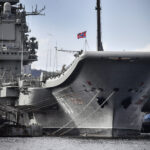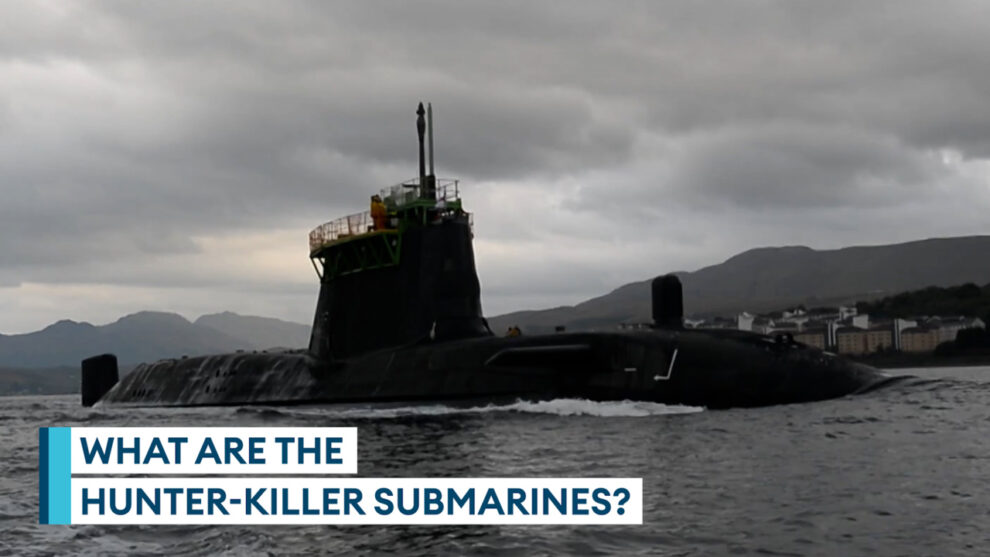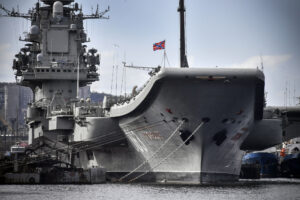Attack submarines, which are also known as hunter-killer submarines, are designed to be stealthy, fast and highly capable.
Equipped with the latest technology and weapons, attack submarines are multi-role and nuclear-powered, but conventionally armed. They are the jack-of-all-trades backbone of the fleet.
Although they are primarily designed to seek and destroy enemy submarines and surface ships, they can do a lot more.
An attack submarine also has the capability to carry out short-range attacks with cruise missiles, surveillance and intelligence missions, and undersea warfare.
Aukus
In March the US, Australia and Britain unveiled a ground-breaking defence deal that is intended to counter China’s increasing military assertiveness in the Pacific, by providing Australia with nuclear-powered attack submarines from the early 2030s.
Britain will also operate the submarines, currently known as SSN-Aukus.
The Aukus agreement will provide the Royal Navy with replacements for its seven Astute submarines, potentially doubling the size of the fleet of its attack boats, but the vessels will not be nuclear-armed.
They will be built in Britain and Australia to a British design and use a significant amount of US technology.
Prime Minister Rishi Sunak said that the nations would work together “keeping our oceans free” with the new generation of attack submarines.
What are SSN-Aukus replacing?
The current Astute-class was commissioned in 2010 and is the most advanced in the Royal Navy fleet.
They are powered by a Rolls-Royce nuclear reactor which allows them to operate for extended periods without the need to surface.
Thanks to a stealthy shape, they are quiet, with the hull being covered in noise-reducing tiles that absorb active sonar.
Passive sonar enables Astute submarines to detect and track other vessels without emitting any signals that could give away their position.
They are loaded with countermeasures, decoys and jammers to confuse and defeat incoming torpedoes or missiles.
But the new Aukus subs promise to be the largest and most powerful ever operated by the Royal Navy.

The team-player approach to underwater warfare
International Institute for Strategic Studies (IISS) naval forces and maritime security expert Nick Childs told Forces News: “There will be some added US technology as far as the propulsion system is concerned, so it’s probably going to have a more powerful, more stealthy reactor compartment and nuclear propulsion setup.”
The expert from the authority on global security, political risk and military conflict added: “A key extra capability is a vertical launch system, possibly with a wider variety of potential missile systems. There’s much talk of having hypersonic capabilities in the future.
“But it will also involve a whole range of other remote systems that will be a part of a team player approach to underwater warfare.”
Why are attack submarines needed?
The move is being driven by a need to counter China’s ambitions in the Indo-Pacific region, as well as concerns about Russia, Iran and North Korea.
Russia is also pushing advances in its submarine technology.
Last year, its navy took delivery of the giant K329 Belgorod attack submarine – the largest built in 40 years.
It is designed to carry the Poseidon mega-torpedo, a long-range, nuclear-powered and nuclear-armed underwater drone that is currently under development.
With these dangers in mind, it is possible the UK fleet could be doubled as part of the new deal.
When will Aukus be rolled out?
According to a senior White House official, phase one is already underway with US and UK submarines visiting ports in Australia.
The official added: “Australian sailors will increasingly embed in US and UK submarine forces and nuclear power schools.
“This has already started, and in the coming months there’ll be Australian workers in our shipyards. And starting this year, Australia will be building up its facilities and infrastructure to house Australia as well as US and UK submarines.”
In 2022, the US accepted its first Royal Australian Navy personnel into nuclear propulsion training programmes, with additional personnel planned in the coming years.
Congress also approved Royal Australian Navy submarine officers to train at the Naval Nuclear Power Training Command and eventually serve on operational US submarines. The UK has also welcomed Australian submariners onto the Royal Navy’s nuclear courses.
Source : Forces Net











